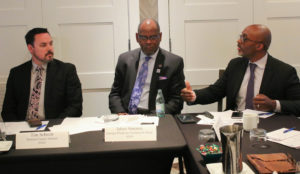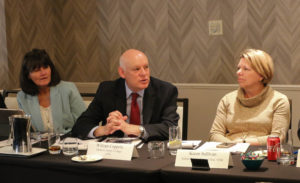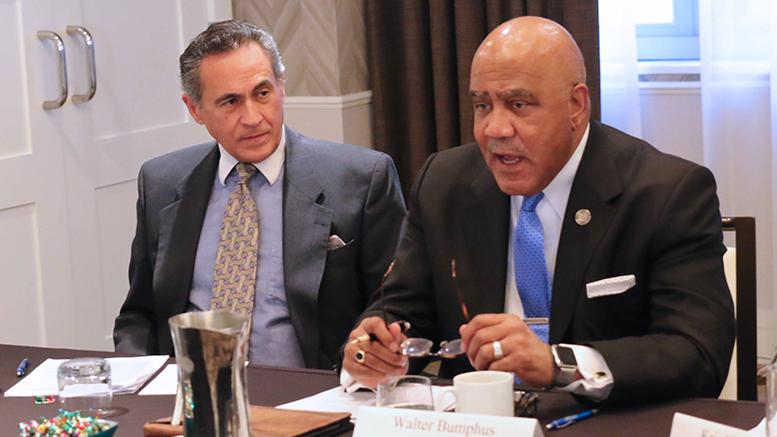Community college leaders and K-12 superintendents this week discussed the role K-12 systems and partnering community colleges can play in workforce and economic development.
The topic was a key part of a meeting between members of the American Association of Community Colleges (AACC) and AASA, The School Superintendents Association, which over the past four years have held occasional meetings to discuss issues regarding college and career readiness.
High schools are often not in the loop when it comes to local discussions about workforce and economic development, but educators, businesses and local leaders are exploring ways to better prepare high school students for careers, whether they directly go to work after graduation or continue on to college.

Community college and K-12 leaders discuss the challenges around local workforce development efforts.
Community colleges are well known for their workforce education programs, and many already partner with K-12 systems through special programs, such as academies, that focus on general career pathways. But business and industry still cannot find enough skilled workers, especially in career and technical fields. Educators are now looking for ways to allow students and their families to become aware of those career options even before high school.
Education advocates note that it’s still a challenge to discuss with families about careers in areas such as manufacturing, as many people still have the misperception that today’s manufacturing facilities are dirty and dangerous. One of the ways to overcome that is to reach out to families earlier than high school to show them that many manufacturing jobs today require higher skills, pay well and are in safe, well-lit facilities.
What lies ahead
John Dyer, AACC’s director of workforce and economic development, highlighted the association’s efforts in preparing the nation’s workforce for available jobs, which usually include partners such as K-12 systems, four-year institutions, government, workforce investment boards, and business and industry. Some of those include The Right Signals initiative, which focuses on skills assessments and credentialing, to the sunsetting federal Trade Adjustment Assistance Community College and Career Training program (see related story), which brought together myriad partners in a region to focus on workforce development for specific career fields.

William Coppola, president of Tarrant County College’s Southeast Campus (Texas), highlights pre-apprenticeship opportunities offered through his college.
The Trump administration’s focus on apprenticeships has prompted AACC to look at promising programs among its member colleges that it is sharing with the administration, Dyer said. A key element in discussions is what constitutes an apprenticeship, as they can be formal — such as ones registered with the federal government — or informal, as long as they involve some form of work-based learning. The latter is preferred among most businesses because they involve less bureaucratic red tape and can serve more students, including older students, Dyer said.
High schools also are becoming more involved in such programs by offering “pre-apprenticeship” programs that provide work-based learning that prepare students to apply for more formal apprenticeships. The education leaders at the meeting shared examples of high school and community college pre-apprenticeship programs in Washington state, Pennsylvania, Texas and Illinois, in an array of industries from welding and manufacturing, to biomedicine and engineering.
Overlapping missions

Anthony Carnevale directs the Georgetown University Center on Education and the Workforce.
The overlapping missions of education and workforce training to prepare students for careers is “not going to go away,” Anthony Carnevale, director of the Georgetown University Center on Education and the Workforce, told the education leaders. Although nearly all career and technical education (CTE) now occurs at the postsecondary level, K-12 systems need to become more involved to expose students to various career options in the trades, he said. The tricky part is how to do that, as many Americans are concerned that could lead to their children being tracked in vocational jobs. Offering high school students more internship opportunities to explore potential careers could be an option.
“We’re fine with tracking people in college. We’re not fine with tracking people in high school,” Carnevale said.
A major challenge is educating parents, school counselors and K-12 leaders that CTE leads to well-paying jobs typically at the fraction of the cost of attending a four-year institution, he said.
Other topics discussed at the AACC/AASA meeting included professional development for teachers, accreditation issues regarding work-based learning, and seeking new funding sources and revenue sharing.

